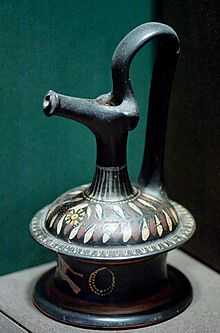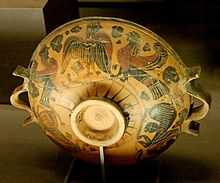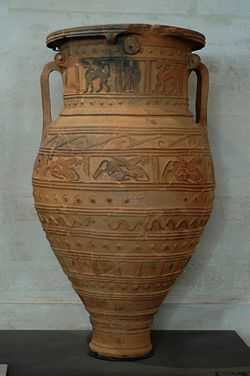Typology of Greek vase shapes
Pottery in Greece has a long history and the form of Greek Vase Shapes has had a continuous evolution from the Minoan period down to the Hellenistic era. As Gisela Richter puts it the forms of these vases find their “happiest expression” in the 5th and 6th centuries BC, yet it has been possible to date vases thanks to the variation in a form’s shape over time, a fact particularly useful when dating unpainted or plain black-gloss ware.
The task of naming Greek vase shapes is by no means a straightforward one. The endeavour by archaeologists to match vase forms with those names that have come down to us from Greek literature began with Panofka’s 1829 book Recherches sur les veritables noms des vases grecs, whose confident assertion that he had rediscovered the ancient nomenclature was quickly disputed by Gerhard and Letronne. A few surviving vases were labelled with their names in antiquity; these included a hydria depicted on the François Vase and a kylix that declares, “I am the decorated kylix of lovely Phito” (BM, B450). Vases in use are sometimes depicted in vase paintings, which can help scholars interpret written descriptions. Much of our written information about Greek pots comes from such late writers as Athenaios and Pollux and other lexicographers who described vases unknown to them, and their accounts are often contradictory or confused. With those caveats, the names of Greek vases are fairly well settled, even if such names are a matter of convention rather than historical fact.
The following vases are mostly Attic, from the 5th and 6th centuries, and follow the Beazley naming convention.
Key terms
| Foot | Lip |
|---|---|
 Disk |
 Flaring |
 Echinus |
 Inverted Echinus |
 In several degrees | |
 Torus |
Vase shapes
-

Amphora type A, c. 520 BC.
-

Amphora type B.
-

Amphora type C.
-

Neck Amphora, c. 520 BC.
-

Ovoid neck amphora
-

Nikosthenic amphora, c. 530 BC.
-

Panathenaic Amphora
-

Pseudo-panathenaic amphora, c. 500 BC.
-

Pointed amphora
-
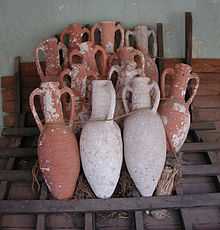
Transport amphorae
-

Pyriform Aryballos
-

Globular aryballos
-

Siana cup
-

Fish Plate
-

Glaux skyphos
-

Hydria-black figure type
-

Hydria-red figure type or Kalpis
-

Kantharos type A
-

Kantharos type B
-

Bell Krater, c 330 BC.
-

Calyx-Krater, c. 510 BC.
-

Column Krater
-

Volute Krater
-
Kylix type A
-
Kylix type B
-

Lebes Gamikos, c. 340 BC
-
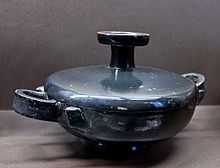
Lekanis
-

Acorn lekythos
-

Deianeira lekythos, c. 550 BC.
-

Shoulder or secondary lekythos, c. 500 BC.
-

Standard or cylinder lekythos c.490 BCE.
-

Squat lekythos
-

Mastoid
-

Nestoris (Trozella)
-

Oinochoe Shape 1
-

Oinochoe Shape 2
-

Oinochoe Shape 3
-

Oinochoe Shape 7
-

Olpe
-

Pinax (plaque)
-

Phiale
-

Phormiskos (here a terracotta model)
-

Plate
-

Pyxis, c. 470 BC.
-

Pointed pyxis
-

Rhyton, c. 430 BCE.
-

Skyphos, c. 740 BC
-

Hermogenes skyphos
-

Stamnos, c. 480–470 BC.
See also
- Pottery of ancient Greece
- Greek Terracotta Figurines
- Art in Ancient Greece
- Ancient Greek sculpture
- Minoan pottery
- Black-figure pottery
- Red-figure pottery
- List of Greek Vase Painters
References
- Gisela M. A. Richter, Marjorie J. Milne, Shapes and Names of Athenian Vases, Metropolitan Museum of art, New York, 1935.
Further reading
- Von Bothmer, Dietrich (1987). Greek vase painting. New York: The Metropolitan Museum of Art. ISBN 0870990845.
External links
| Wikimedia Commons has media related to Ancient Greek pottery by shape. |
| ||||||||||||||||||||||||||||||||||||||












